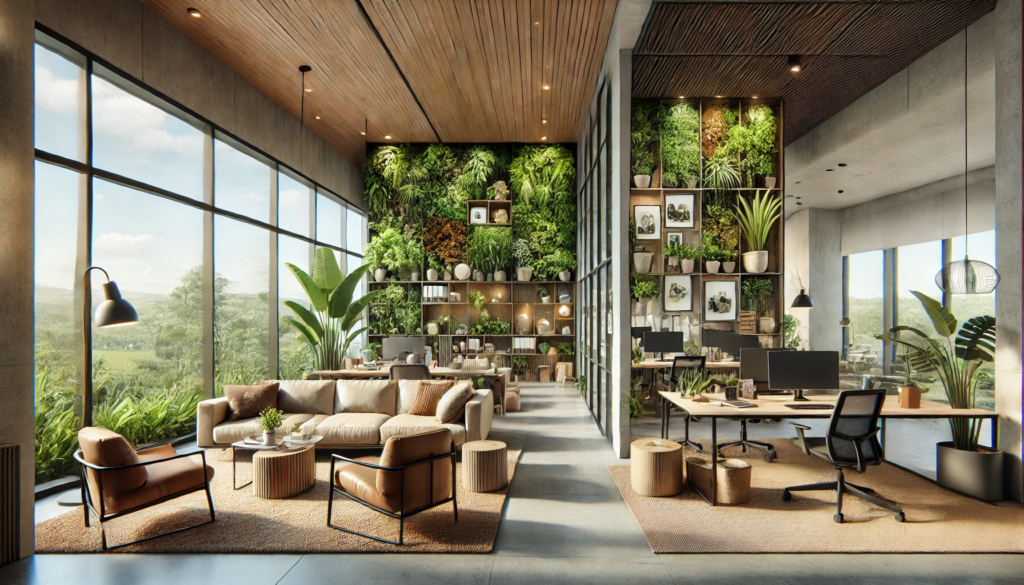The world of interior design is ever-evolving, with new interior trends emerging each year to redefine how we shape and experience our spaces. This year’s trends are all about creating environments that balance style, comfort, and individuality. The key is to incorporate trends in a way that resonates with your personal taste and lifestyle. After all, the best trends are the ones that make you feel at home!
Earthy and Natural Tones of Interior Trends
Neutral and earthy tones continue to dominate, offering a calming and grounding effect in interiors. Think warm browns, sandy beiges, terracotta, and muted greens that bring the outdoors in. These tones pair well with natural textures like wood, stone, and linen. And creating spaces that feel serene and connected to nature.
Curved and Organic Shapes
Say goodbye to sharp edges and straight lines—this year is all about embracing curves and organic forms. From arched doorways and rounded furniture to sculptural decor pieces, soft shapes add a sense of fluidity and comfort to any space. These designs not only feel modern but also evoke a sense of playfulness and sophistication.
Statement Lighting in Interior Trends
Lighting has moved beyond its functional role to become a key design element. Bold, artistic lighting fixtures are taking center stage in modern interiors. Think oversized pendant lights, geometric chandeliers, and fixtures made from unexpected materials like woven rattan or frosted glass. These pieces not only illuminate a room but also serve as stunning focal points.
Sustainable and Recycled Materials
Eco-conscious design continues to shape interior trends, with a strong emphasis on sustainability. Expect to see more furniture and decor crafted from recycled materials, reclaimed wood, and eco-friendly fabrics. Sustainability also extends to choosing timeless pieces. That reduce the need for frequent replacements, promoting a more mindful approach to decorating.
Vibrant Color Accents
While neutral tones remain popular, vibrant accent colors are making a comeback in interior trends. Bright yellows, deep blues, and rich reds are being used strategically to add pops of color and energy to otherwise muted spaces. Incorporate these hues through throw pillows, rugs, or artwork for an eye-catching yet balanced look.
Texture-Rich Layers in Interior Trends
Layering textures is a key interior trend for creating depth and visual interest in a space. Think chunky knit blankets, woven baskets, velvet cushions, and boucle fabrics. Mixing and matching different textures adds warmth and character, making rooms feel more inviting and dynamic.
Biophilic Design
The biophilic trend continues to thrive, emphasizing a connection to nature through plants, natural materials, and earthy color palettes. Indoor plants, living walls, and even nature-inspired wallpapers are becoming staples in modern homes. This approach not only enhances aesthetics but also promotes well-being and a sense of tranquility.
Multifunctional Spaces in Interior Trends
With more people working and studying from home, multifunctional spaces are more relevant than ever. Furniture designs are adapting to serve dual purposes, such as desks that transform into dining tables or modular sofas with built-in storage. These versatile solutions make the most of available space while maintaining a stylish aesthetic.
Maximalism with Personal Touches
Maximalism is back in modern interior trends. But with a twist—it’s all about meaningful personal expression. Bold patterns, vibrant colors. And an eclectic mix of styles are key elements. The trend encourages showcasing unique pieces like heirlooms, travel finds, or DIY decor that tell a story and reflect individuality.
Vintage and Retro Revival
Retro styles from the mid-century modern and 1970s eras are making a strong comeback. Vintage furniture with clean lines, bold geometric patterns, and nostalgic color palettes like mustard yellow and avocado green are adding a touch of nostalgia to contemporary homes. Incorporating vintage pieces also ties into the sustainability trend. Giving new life to old treasures.
Dark Kitchens and Bathrooms
While white kitchens and bathrooms have been a timeless choice. Darker, moodier tones are gaining popularity in modern interior trends. Deep blues, blacks, and dark greens create a sense of drama and sophistication. Paired with metallic accents and soft lighting, these spaces feel luxurious and modern.
Artisanal and Handmade Pieces
There’s a growing appreciation for the imperfect beauty of handmade and artisanal items. Hand-thrown pottery, woven textiles, and hand-carved furniture bring a human touch to interior trends. These pieces not only add character but also support local artisans and sustainable practices.
KlugKraft is the premier online destination for system integrators and interior designers to showcase their home & office automation products. This platform is meticulously crafted to highlight the synergy between innovative technology and elegant design. Providing a comprehensive portfolio space for professionals. KlugKraft allows experts to display their latest smart home technologies, from intuitive lighting solutions to sophisticated security systems, all designed to enhance modern living. By offering a dynamic and interactive showcase, KlugKraft not only connects these professionals with potential clients but also sets a new standard in the integration of technology and design in home automation, ensuring every space is as functional as it is visually stunning. KlugKraft (a unit of Smart Group).




